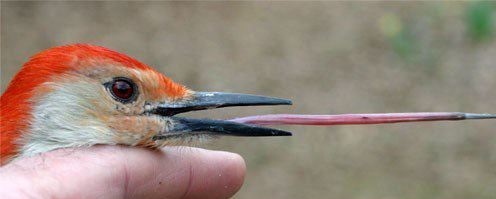Woodpeckers with long tongues have specialized wiry structures that wrap around the skull, but not in direct contact with the brain. This Y-shaped structure consists of stiff, yet flexible, cartilage-and-bone connected to their tongues called the hyoid apparatus. The specialized hyoid apparatus allows woodpeckers to extend their rigid tongues for several inches to probe into cavities and to extract grubs and insects.
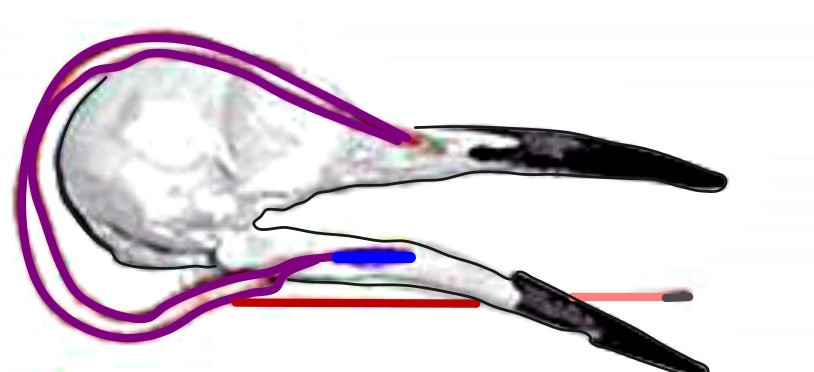
The two long wiry structures of hyoid apparatus, referred to as the hyoid horns, connect to form a Y-shape. In the case of woodpeckers with the longest tongues, the hyoid horns can grow all the way over the top of the skull, around the eye socket, and even into the nasal cavity. Using a combination of long muscles connected to the flexible horns, woodpeckers can extend their tongues much farther than most other birds.

The woodpecker’s long tongue has a barbed tip and is covered in sticky saliva to help the bird capture and extract insects from the holes they drill.
Unlike the tongues of humans, which are primarily muscular, the tongues of birds are rigid and supported by cartilage-and-bone.

Is the Shape of the Tongue Related to Diet?
Various species of woodpecker have shorter or longer tongues based on their feeding habits and the distances probed with their tongues to find food. Some species, such as sapsuckers, have relatively short tongues while others, such as green woodpeckers and flickers, have tongues that can probe 4-5 inches (10–12 cm) or more.
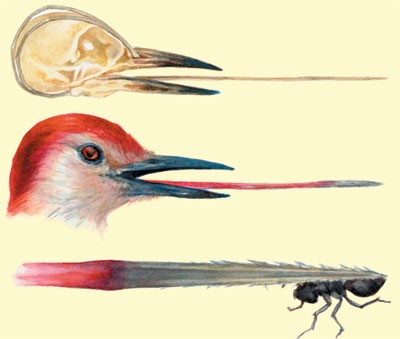
Insect eating woodpeckers often have pointed, barbed tongues for grabbing insects or brush-like tips coated with sticky saliva to help capture them.
Sapsuckers are also woodpeckers, but they don’t have long tongues (and they don’t actually suck up sap). Instead, they have short, bristly tongues to gather oozing sap and occasional insects from the short holes they drill in trees. (BTW, it’s best not to call your friend a yellow-bellied sapsucker.)
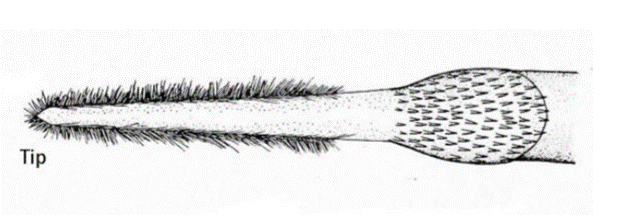
Physical Characteristics of the Woodpecker’s Tongue
Woodpeckers with long tongues need some place to store the tongue when not being used and some sort of support structure for extending it to full length. Woodpeckers have evolved a unique setup by having their long tongues coiled around their skulls to keep them out of the way.
They also have a Y- shaped hyoid apparatus that is composed of stiff, yet flexible, cartilage and bone to provide the support necessary to extend the tongue out full length. The hyoid horns and their muscles are encased in sheaths. The sheath is comprised of two layers of connective tissue with lubricating fluid in between.
The fork in the “Y” is at the front of the throat, and this is where most of the muscles of the hyoid attach. Two long wire-like structures, the “horns” of the hyoid, grow from this area and provide insertion sites for protractor muscles which originate on the lower jaw.
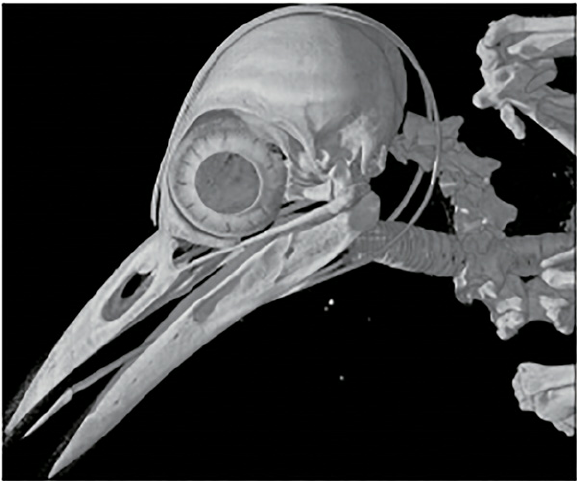
Tip of the Tongue Can Probe in Different Directions
Insect eating woodpeckers with long tongues feature another unique adaptation: a mobile tip that can change direction when probing deep into insect tunnels.
There’s a tiny universal joint in the otherwise rigid tongue (technically between the basihyal and the fused paraglossalia) with two pairs of muscles inside the tongue inserting on tiny bones (the paraglossalia) enabling movement of the horny tip of the tongue in all directions.
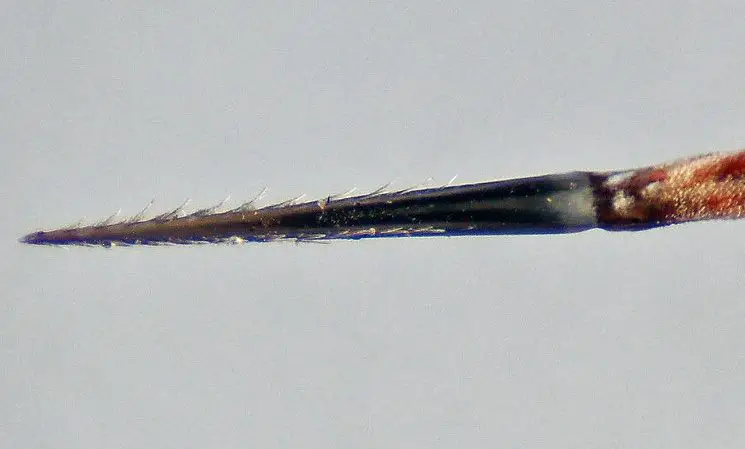
Photo by Chris Kargel. Source: www.livingstonbirds.com/photos/red-bellied_woodpecker/
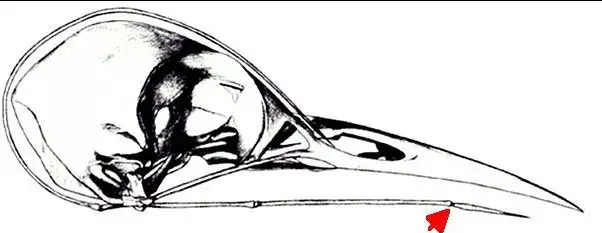
Salivary Glands Produce a Sticky Mucus
In birds, salivary glands are found in various places on the tongue including the root and body. These glands produce saliva and mucus which helps to protect against bacteria and helps to moisten food before swallowing.
Some woodpeckers have an especially sticky mucus which coats the tip of their tongue and aids in extracting ants and insects.
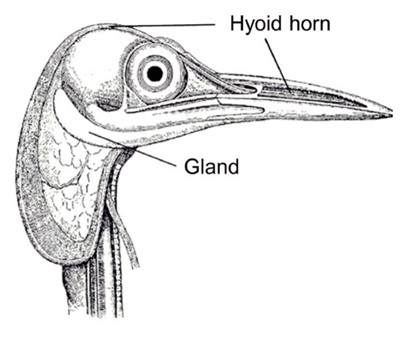
How Does the Woodpecker Extend its Tongue? (Nitty Gritty)
This section provides a deep dive into the morphology of the woodpecker’s tongue and how the hyoid apparatus works. Read on if you want to understand the nitty gritty of how woodpeckers can stick their tongues out for several inches!
Woodpeckers have the same primary connections between the hyoid apparatus and the rest of the body found in all other birds. Muscles and ligaments attach the hyoid to the mandible (jawbone), to the cartilage of the throat, and to the base of the skull.
There’s quite a bit of variation in the length of the hyoid horns among different bird species, but the functionality remains very similar.
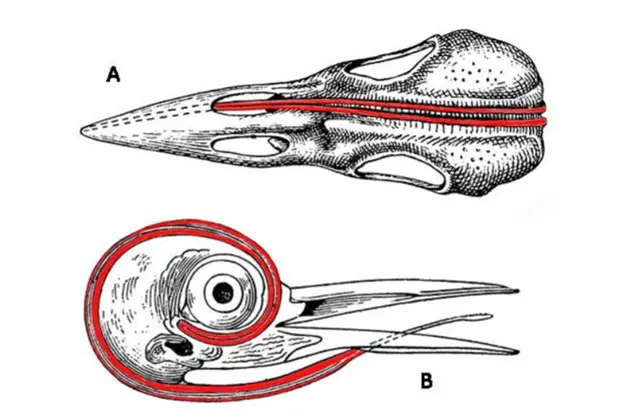
Diagram of the hyoid apparatus shown in red. A: shows how the horns go around the skull and terminate in the right nostril (Northern flicker). B: show how the horns can go around the eye (picus). Modified from Yearbook of the United States Department of Agriculture (Washington: Government Printing Office, 1900) 293
For woodpeckers that can extend their tongue a great distance, the protractor muscles must be very long, at least three times as long as the distance that the tongue protrudes.
The protractor muscles that connect the hyoid horns and the jawbone are called the branchiomandibularis muscles (Mbm). These muscles wrap around the hyoid horns and attach to the jaw. The retracting muscles are called M. cricohyoideus (M cr h).
When a flicker hatches, its hyoid horns are short – extending only as far as its ears, like those of a chicken. Since young flickers are fed by the parents, a long tongue would only get in the way. As the flicker ages, the hyoid horns grow over the top of the head and forward into the nasal cavity, where the sheath fuses to the nasal membrane. In a few forms, such as the North American hairy woodpeckers, the hyoid horns do not enter the right nostril but, instead, encircle the right eyeball orbit.
The hyoid horns grow within a sheath that forms from a sack of lubricating fluid. This lubrication reduces friction as the horns to slide inside the sheath with the tongue as it is extended and retracted. There are some elastic connections between the sheath and horns, but the horns are not attached to the skull.
The protractor muscles (branchiomandibularis muscles labeled “Mbm”) connect near the end of the hyoid horns, run the length of the sheath, and attach to the middle of the jawbone. These are the muscles which slide the horns within the sheaths, tightening them against the skull, and thus extending the rigid avian tongue.
In woodpeckers with longer horns, a great deal of slack is present in the horns at rest, and the contraction of the protractor muscles pulls them tight to the skull as the tongue is extended (see the diagram below).
Diagram of short- (left) and long-tongued (right) woodpecker skull and hyoid apparatus.

Short- (left) and long-tongued (right) woodpecker skulls showing the hyoid apparatus. Purple bands show the action of branchiomandibularis muscle (Mbm) during tongue extension. Attachments of Mbm to hyoid horns and mandible (jawbone) are shown in blue. Green arrows show the direction of movement of hyoid horns when the Mbm is shortened. (adapted from Ryan 2003)
Watch the Hyoid Apparatus in Action
Here’s an excellent video from WitmerLab at Ohio University showing how the hyoid apparatus works on a real bird specimen. This demonstration uses a dissected skull of the red-bellied woodpecker, just in case you are squeamish!
Like this video? You might also be interested in the fascinating locking mechanism that albatrosses have evolved to keep their wings stretched open without any effort on their part. Warning: the video shows a dissected albatross wing.
How Did the Woodpecker’s Tongue Evolve?
The ancestors of today’s woodpeckers likely began to seek for grubs and insects deeper and deeper within the crevices and galleries in the wood of trees. Woodpeckers that could extend their tongues far enough to reach their prey would get to pass on their genes. Those woodpeckers with longer hyoid horns were likely better adapted to catching difficult to reach prey, giving them an advantage over those with shorter horns (fitness advantage in evolutionary terms).
The twin horns of a woodpecker’s hyoid serve as attachment sites for muscles which originate in the lower jaw. When these muscles contract the whole hyoid apparatus is pulled forward and against the skull, thrusting the tongue out like a spear.
It is important to note that the underlying morphology of the woodpecker’s tongue and hyoid apparatus is not very different from that of the other birds.
As the hyoid horns and attached muscles became longer through natural selection and mutation, woodpecker tongues could protrude farther out of the mouth without making any other changes to overall structure or function.
In fact, as we’ve seen, this is exactly what happens as a young woodpecker grows into an adult.
What are Some Other Woodpecker Adaptations?
In addition to their specialized tongues, woodpeckers have several more adaptations that work together as they pound and chisel their beaks into wood with high-speed, high-velocity taps to find and extract their favorite foods.
- Most woodpeckers have a robust beak with a chisel-like tip for drilling holes in wood.
- Woodpeckers have thick, spongy skulls to absorb the repeated impacts of pounding their beaks into solid wood.
- Woodpecker brains are very tightly encased within the skull to help prevent brain damage.
- The eyes of woodpeckers are protected by special membranes that prevent them from popping out of the sockets while the bird is pounding away at the wood.
References
Bock, W.J. 1999. Functional and evolutionary morphology of woodpeckers. In: Adams, N.J. & Slotow, R.H. (eds) Proc. 22 Int. Omithol. Congr., Durban. Ostrich 70 (1): 23-31.
Johnston, N. E. 2014 The Avian Tongue. nejohnston.org/Birds/documents/AvianTongues_Johnston.pdf
Lee, Nayeon, et al. “The geometric effects of a woodpecker’s hyoid apparatus for stress wave mitigation.” Bioinspiration & biomimetics 11, no. 6 (2016): 066004.
Liu, Yuzhe & Qiu, Xinming & Zhang, Xiong & Yu, T.. (2015). Response of Woodpecker’s Head during Pecking Process Simulated by Material Point Method. PloS one. 10. e0122677. 10.1371/journal.pone.0122677.
Ryan, R. 2003. Anatomy and Evolution of the Woodpecker’s Tongue. http://www.talkorigins.org/faqs/woodpecker/woodpecker.html
Zhou P., Kong X. Q., Wu C. W. & Chen Z. 2009. The novel mechanical property of tongue of a woodpecker. Journal of Bionic Engineering volume 6, pages 214–218

